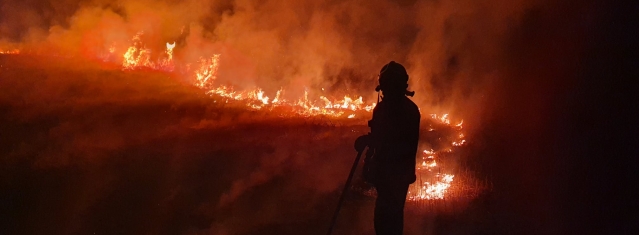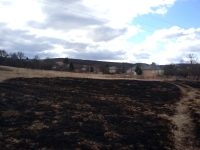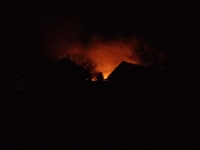News
Hungary Experienced an Especially Dry Year in 2021
Fire Ban In Place

Fighting recent grass fire in Hungary (Source: Source: BM Directorate General for Disaster)
USPA NEWS -
Precipitation in Hungary was a little more than 500 mm in 2021, almost 20 percent below average, making it one of the driest years since the collection of data began in 1901, according to the Hungarian Meteorological Service (OMSZ).
The dry conditions and countrywide fire ban is not stopping individuals from lighting fires outside. The mild winter conditions that Hungary has experienced has everyone starting their preparations for spring rather early. It is popular here to burn tall grass, rather than cutting it, and to burn field stubble to encourage fresh grass growth for animal grazing. Because of the increase in the tick population, there are some that believe burning will also kill off ticks. Additionally, it is also still commonplace to burn trash. All of these reasons have led to an increase in fires that became out of control that last few weeks, due to the extremely dry conditions that exist. In the village where I live, there have been at least four fires recently that were not kept under control. One in particular came within 150 feet of my home. One was from someone burning trash and the others were to encourage regrowth for grazing purposes. Those who start the fires do not seem to realize that even a small amount of wind can make the fire spread and difficult to manage.
The closest fire to my home occurred on a Sunday afternoon. I had no idea what was going on until a friend messaged me. He thought I saw the fire, but because of where I was in my living room, the wind was not blowing the smoke passed the window. Had I been in my kitchen, I would have noticed. Most of the homes in the area are made of stone and brick, so they are close to being fire proof. That does not mean damage couldn’t be done, with someone getting injured or killed. Getting trapped in your home while everything burns around it is also a possibility. Many of my neighbors have dogs and other animals that live outside. You see where I am going with this. Since the fire, I have not seen any deer. It was common for me to see them several times a day, grazing. The pheasants that were in my neighborhood must have moved to another part of the village, because I have not seen as many as I once did. Some things may regrow after a fire, while other things can be destroyed. The ants have been resilient. Their mounds have changed though. Instead of low to the ground hills, They are more tall and slender since the fire.
A week later, on a Saturday evening, I could see a glow reflecting in some pictures hanging on my wall. When I got up to see what it was, I then saw fire to the west. Our village lies in a valley surrounded by hills on the edge of the Bukk Mountain range in eastern Hungary. A very scenic and beautiful area, when it is not marred by fire. The hills that border the area are used by sheep and cattle farmers to allow their animals to graze. Burning the hillsides are only meant to stimulate fresh grass growth for the livestock. It never gets high enough to be a nuisance. In researching whether burning is actually beneficial, I have found varied opinions. Some believe in it, while others do not. Trying to stick to the facts and trusted sources and methods, this is what I have found. Prairie grass depends on fires for rejuvenation. Fire helps to maintain the ecosystem and helps to prevent woodlands from encroaching on dominant grasslands. Just as we maintain our lawns, other areas need to be controlled to prevent overgrowth. This I can understand. We really cannot run around the countryside keeping everything trimmed back. This type of burning needs to be done correctly though. Improper burning can reduce grass yield by 50-70%. Then we have to consider what the US Environment Protection Agency has to say - “ burning produces various compounds toxic to the environment including nitrogen oxides, volatile organic compounds (VOCs), carbon monoxide, and particle pollution.” With the recent fires, the smoke settles in our valley and takes time to dissipate. I can understand the need for controlled burning, with the emphasis on controlled. There is a fire ban in place for the whole country of Hungary right now. I would hope that those who insist on continuing their habits will do so with more thought and protection.
Thank you for reading my article. These are merely my thoughts and insights based on the facts. I use only verified sources. No fake news here. You can follow me on Instagram at @wendywesthoven or on Twitter at @wendy_westhoven.
Wendy writes for the United States Press Agency and is a former columnist with the Fulton County Expositor, Wauseon, Ohio.
Sources:
About Hungary. (2022, January 7). OMSZ: Hungary Experienced Dry Year in 2021. Retrieved from https://abouthungary.hu/news-in-brief/omsz-hungary-experienced-dry-year-in-2021.
Government of Nova Scotia. (2021). Dispelling Some Common Myths About Grass Burning . Retrieved from https://novascotia.ca/natr/forestprotection/wildfire/firecentre/grass-burning.asp.
US Environmental Protection Agency. (2016). Environmental Effects. Retrieved from https://archive.epa.gov/epawaste/ nonhaz/municipal/web/html/env.html.
Wendy writes for the United States Press Agency and is a former columnist with the Fulton County Expositor, Wauseon, Ohio.
Sources:
About Hungary. (2022, January 7). OMSZ: Hungary Experienced Dry Year in 2021. Retrieved from https://abouthungary.hu/news-in-brief/omsz-hungary-experienced-dry-year-in-2021.
Government of Nova Scotia. (2021). Dispelling Some Common Myths About Grass Burning . Retrieved from https://novascotia.ca/natr/forestprotection/wildfire/firecentre/grass-burning.asp.
US Environmental Protection Agency. (2016). Environmental Effects. Retrieved from https://archive.epa.gov/epawaste/ nonhaz/municipal/web/html/env.html.
more information: https://www.westhoven.uspa24.com/
Liability for this article lies with the author, who also holds the copyright. Editorial content from USPA may be quoted on other websites as long as the quote comprises no more than 5% of the entire text, is marked as such and the source is named (via hyperlink).








